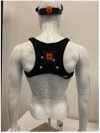Reliability of a Wearable Motion Tracking System for the Clinical Evaluation of a Dynamic Cervical Spine Function
- PMID: 36772486
- PMCID: PMC9920144
- DOI: 10.3390/s23031448
Reliability of a Wearable Motion Tracking System for the Clinical Evaluation of a Dynamic Cervical Spine Function
Abstract
Neck pain is a common cause of disability worldwide. Lack of objective tools to quantify an individual's functional disability results in the widespread use of subjective assessments to measure the limitations in spine function and the response to interventions. This study assessed the reliability of the quantifying neck function using a wearable cervical motion tracking system. Three novice raters recorded the neck motion assessments on 20 volunteers using the device. Kinematic features from the signals in all three anatomical planes were extracted and used as inputs to repeated measures and mixed-effects regression models to calculate the intraclass correlation coefficients (ICCs). Cervical spine-specific kinematic features indicated good and excellent inter-rater and intra-rater reliability for the most part. For intra-rater reliability, the ICC values varied from 0.85 to 0.95, and for inter-rater reliability, they ranged from 0.7 to 0.89. Overall, velocity measures proved to be more reliable compared to other kinematic features. This technique is a trustworthy tool for evaluating neck function objectively. This study showed the potential for cervical spine-specific kinematic measurements to deliver repeatable and reliable metrics to evaluate clinical performance at any time points.
Keywords: inter-rater; intra-rater; musculoskeletal disorder; neck function; reliability; wearables.
Conflict of interest statement
The authors declare no conflict of interest.
Figures






Similar articles
-
Reliability of a Wearable Motion System for Clinical Evaluation of Dynamic Lumbar Spine Function.Adv Complement Altern Med. 2022;7(2):672-683. doi: 10.31031/acam.2022.07.000660. Epub 2022 Jul 6. Adv Complement Altern Med. 2022. PMID: 36816092 Free PMC article.
-
A novel virtual reality application for autonomous assessment of cervical range of motion: development and reliability study.PeerJ. 2022 Sep 14;10:e14031. doi: 10.7717/peerj.14031. eCollection 2022. PeerJ. 2022. PMID: 36124134 Free PMC article.
-
The reliability and validity of a novel wearable inertial sensor to measure the cervical proprioception.Med Eng Phys. 2024 Mar;125:104125. doi: 10.1016/j.medengphy.2024.104125. Epub 2024 Feb 20. Med Eng Phys. 2024. PMID: 38508802
-
Validity and reliability of clinical prediction rules used to screen for cervical spine injury in alert low-risk patients with blunt trauma to the neck: part 2. A systematic review from the Cervical Assessment and Diagnosis Research Evaluation (CADRE) Collaboration.Eur Spine J. 2018 Jun;27(6):1219-1233. doi: 10.1007/s00586-017-5301-6. Epub 2017 Sep 22. Eur Spine J. 2018. PMID: 28940048
-
Reliability and validity of clinical tests to assess posture, pain location, and cervical spine mobility in adults with neck pain and its associated disorders: Part 4. A systematic review from the cervical assessment and diagnosis research evaluation (CADRE) collaboration.Musculoskelet Sci Pract. 2018 Dec;38:128-147. doi: 10.1016/j.msksp.2018.09.013. Epub 2018 Oct 5. Musculoskelet Sci Pract. 2018. PMID: 30455032
Cited by
-
Cervical misalignment in motorcyclists in relation to new helmet removal recommendations shown with augmented reality resources: A biomechanical analysis.Heliyon. 2024 Mar 8;10(6):e27428. doi: 10.1016/j.heliyon.2024.e27428. eCollection 2024 Mar 30. Heliyon. 2024. PMID: 38524555 Free PMC article.
References
MeSH terms
Grants and funding
LinkOut - more resources
Full Text Sources
Medical

